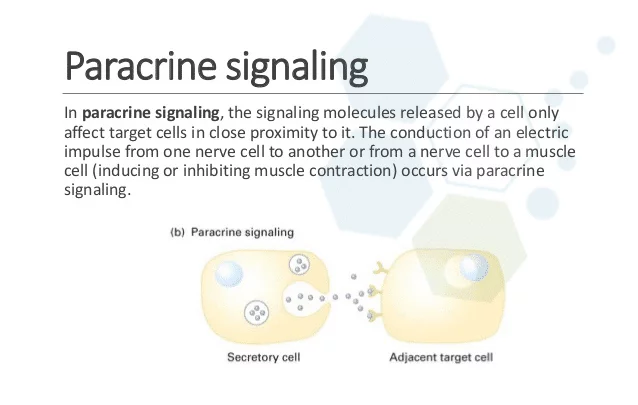What is Paracrine Communication?
Paracrine signaling also known as Paracrine communication is a natural method of communication between cells that causes desired changes in surrounding cells and chemically altering the behavior surrounding cells.
Why is paracrine signaling important?
The paracrine communication system, exosomes and cytokines are critical for the success of functional medicine, regenerative medicine, and stem cell therapies. The signaling allows for significant improvements in wound healing, neurogenesis and tissue repair for medical conditions such as heart disease (cardiac tissue engineering) and orthopedic injuries to knee, hips and foods that can help prevent arthritis. Through paracrine cell communication comes the secretion of unique signaling molecules and trophic factors used at the Regeneration Center for human body repair process and is one of the best ways to naturally increase your body’s stem cells.
Differences between Paracrine, Endocrine, Autocrine, and Exocrine
The primary difference between the Exocrine, Endocrine, paracrine and autocrine systems is the use of the medium in which they are released. The Endocrine system is usually a long slow response that is secreted into the blood system. The Exocrine response is usually via ducts such as the sweat glands. The Autocrine response occurs when hormones bind to cell receptors to effects the cells that produce it. An example is the use of cell-specific growth factors used in treatments that force cell division.
Examples of Paracrine Hormones
TGF-β cell family are good examples and usually involved in the regulation of cell division. This cell family includes Bone morphogenetic proteins, TGF-β1, TGF-β2, TGF-β3, and TGF-β5. Another example of auto paracrine signaling can be found in motor neurons – nerve cells and how they transfer signals across the synapses. Nerve cells are made up of a cell body & short branch shaped extensions known as dendrites. Dendrites are responsible for receiving stimuli via the axon, which then transmits the cell signals to other surrounding nerve cells or muscle cells in the body.
Paracrine signaling is a form of cell-to-cell communication in which a cell produces a signal to induce changes in nearby cells, altering their behavior or differentiation. This type of signaling is distinct from autocrine signaling (where a cell signals to itself), endocrine signaling (where cells produce hormones that travel through the bloodstream to distant target cells), and juxtacrine signaling (where signaling molecules are not secreted but rather presented on the cell surface to interact with adjacent cells).
The Notch pathway & paracrine signaling
- Signal Molecules: Paracrine signals consist of molecules that are secreted by cells and act on nearby cells. These signaling molecules can include peptides, growth factors, cytokines, and other types of signaling molecules.
- Short Range Communication: Paracrine signaling is often characterized by its localized, short-range effect. Once secreted, paracrine factors do not typically travel far before being taken up, degraded, or bound and activated nearby target cells.
- Growth Factors: These are proteins or hormones that play a significant role in cellular growth, proliferation, and differentiation. For instance, fibroblast growth factor (FGF) and vascular endothelial growth factor (VEGF) function through paracrine signaling to promote wound healing and angiogenesis, respectively.
- Neurotransmitters: In the nervous system, neurons communicate with each other by releasing neurotransmitters that act on nearby neurons, typically across a synapse. While this is a specialized type of signaling, it bears similarities to paracrine communication.
- Eicosanoids: These are signaling molecules derived from arachidonic acid, like prostaglandins, that often have localized actions.
- Functional Significance & Tissue Repair: After injury, paracrine signals can stimulate cells to proliferate and repair the tissue.
- Angiogenesis: The growth of new blood vessels from existing ones, crucial in wound healing, embryonic development, and cancer progression, is driven by paracrine factors like VEGF.
- Development of paracrine: During embryonic development, paracrine signaling plays a pivotal role in cell differentiation and the establishment of tissue patterns.
- Clinical Implications & Therapeutic Targets: Due to their roles in processes like angiogenesis and tissue repair, paracrine factors are often targeted in medical therapies. For example, inhibitors of VEGF are used to treat certain forms of lung cancer, liver cancer, pancreatic cancer and macular degeneration.
- Stem Cell Therapies: The stem cell therapies at the Regeneration Center rely not on the differentiation potential of the stem cells themselves, but on their ability to keep secreting paracrine factors that assist in tissue repair and organ regeneration.
Paracrine signaling is a vital mode of intercellular communication, especially in localized tissue environments, and plays essential roles in processes ranging from development to tissue repair and pathology. To learn more biology and neuroscience terms and definitions please visit the regenerative medicine glossary section.

